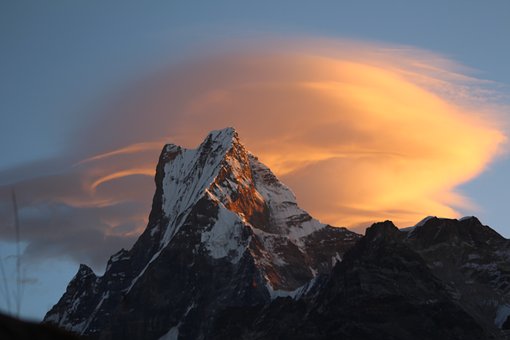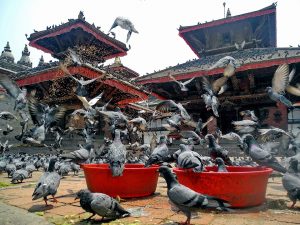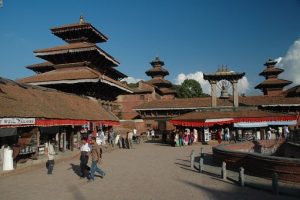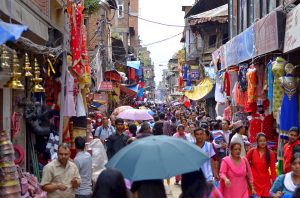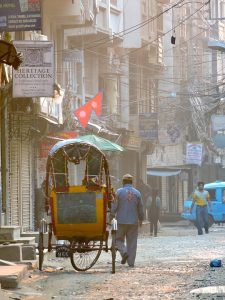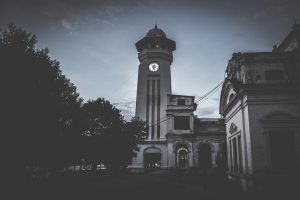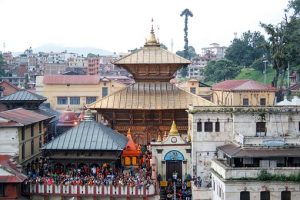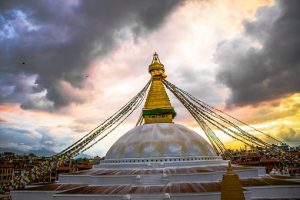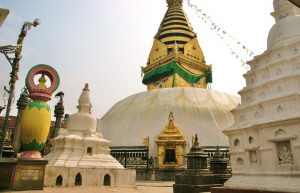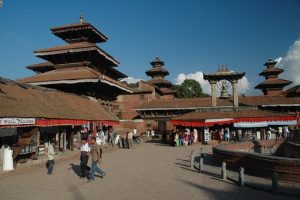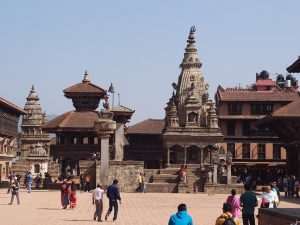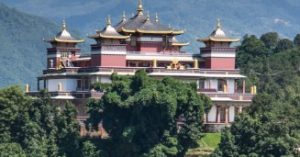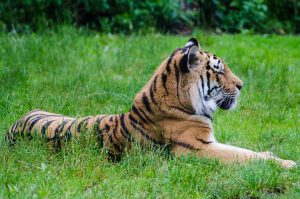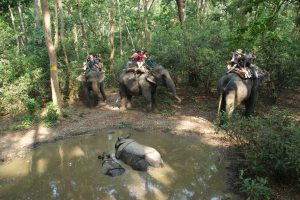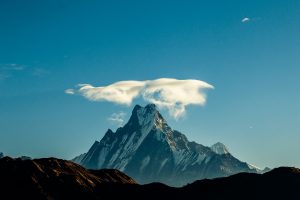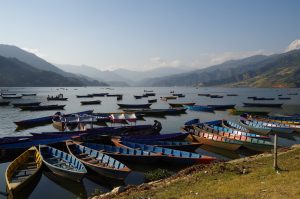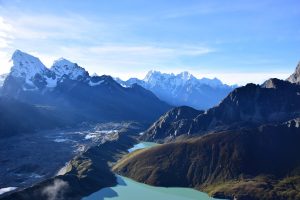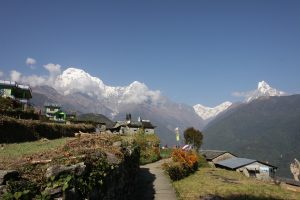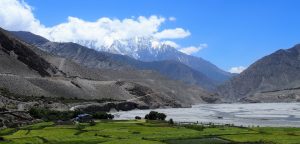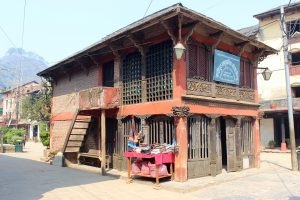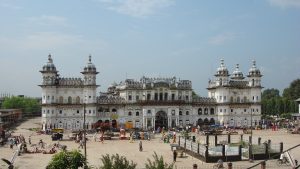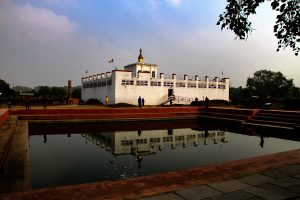There’s a popular saying in Nepal – Heaven is Myth; Nepal is real. Truly, this country is beautiful. Eight out of fourteen Himalaya Tops above 8000 metres lies in Nepal which includes the highest mountain in the world, Mount Everest. Nepal also has world’s highest altitude lake, Lake Tilicho. Nepal also offers deep gorges including Kali Gandaki Gorge which is the deepest gorge in the world along with Himalayan rivers, beautiful valleys, high altitude lakes, magnificent glaciers, stunning panoramic views of highest mountains, trekking options of your choices, mountain climbing, and many other breathtaking options.
- Kathmandu Sightseeing
Known as city of temples, you won’t miss temples wherever you go in Kathmandu. It is ideal for quick tour of few days to several days.
Basantapur Durbar Square – Located in the heart of Kathmandu, you can experience glorious architecture of medieval age. Basantapur Durbar Square was made a UNESCO World Heritage site in 1979.
Temple of the living goddess Kumari is another tourist attraction in Basantapur Durbar Square.
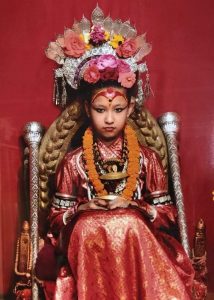
Ason Bazaar (Ason Market) – This has been the most popular shopping hub in Nepal for many many years and also located in the centre of Kathmandu. Nepalese can find anything they want in Ason that they can’t find anywhere else in Nepal.
Thamel – Thamel is a tourist hub. You can find budget hotels, plenty of shops to meet your needs from souvenirs to trekking gears, eateries and pubs. It’s good place to stroll around and socialise with other tourists.
Garden of Dreams – Garden of Dreams lies on the eastern side between Thamel and Royal Palace. It is within 5 minutes walking distance from Thamel centre. You can escape the crowd and the noise to enjoy peace in this garden with ponds, greenery and varieties of fauna.
Royal Palace and Kingsway – Kingsway has five star hotels with casinos, exclusive eateries and high end shops. Kingsway represents modern Kathmandu. Kingsway is the main road starting from the front of main gate of Royal Palace (Nepal is not a kingdom anymore but the palace is still known as Royal Palace – Raj Durbar in Nepalese language). At the other end you will see Ghantaghar (Clock Tower) on the left and Nepal’s oldest college Tri Chandra College which was built in 1918.
Pashupatinath Temple – Pashupatinath Temple is one of the most sacred Hindu temples in the world. Many Hindus around the world visit this temple of lord Siva. It is situated in the banks of Bagmati River. The temple is built in Pagoda style and it is the oldest Hindu temple in Nepal.
Boudha – Boudhanath is one of the largest spherical stupas in Nepal. It is another UNESCO World Heritage site in Nepal. It is about 36 metres high and looks beautiful when lit up at night. There are many monasteries around it. Boudha is popular with Tibetan Buddhists.
Swayambhu Nath Temple (Monkey Temple) – This is one of the holiest Buddhist stupas in Nepal. It is unique to other stupas and believed to be one of the oldest stupas dating back to 460 AD. You can drive to the top and climb only few steps to the temple but it would be a good experience to climb the whole 365 steps from the bottom while viewing small stupas passing several monkeys on your way to the top.
Nagarkot – Nagarkot is popular for panoramic view of the Himalaya Tops and to look sunrise. It is cooler than Kathmandu valley. It takes about 2 hours from Kathmandu in car and just over 30km from Kathmandu. There are many good places to stay and to eat in Nagarkot.
Bhaktapur – Bhaktapur is another city in Kathmandu valley. It is a living museum of medieval time. You will be amazed to see this beautiful city. With pagoda style sky-high temples, glorious architecture, narrow alleys, beautifully carved doors and windows, it is sure to give you one of the most satisfying trips.
Patan – Patan is another city in Kathmandu valley. You do not want to miss travelling to this city. It takes about 20-30 minutes drive from Kathmandu city centre.
Kopan Monastery – This is a beautiful Tibetan monastery located on the outskirts of Kathmandu. You can take a taxi or do 2-3 hours of hike. It is in a perfect tranquil location. You can visit in the morning from Kathmandu to join the morning meditation classes.
Hike to The Champa Devi Temple – Located at an elevation of 2,285m south west of Kathmandu, it consists of a Buddhist Stupa and a Hindu Shrine. You can hire a car to Pharping village which is 19 KMs from Kathmandu which takes about an hour to Pharping. It takes 2 hours from Pharping to hike to the top. You can view central and western Himalaya Tops like Langtang, Gauri Shanker, Jugal etc from the Champa Devi Temple.
- Visit Chitwan National Park
Chitawan National Park is UNESCO World Heritage and one of the best national parks in the world. You can do a jungle walk or elephant safari, canoeing, bird watching, visit elephant breeding centre, crocodile breeding centre, visit Tharu village, watch Bengal tigers or one horned rhinos.
Jungle Safari – 4WD, elephant ride, Jungle walk – 4WD ride is popular among people who do not like to ride on elephant or do not want jungle walk. It’s about 3 hour tour where they take you to deep jungle. You will be able to see rhinos, Bengal tigers, deers, wild boars and will certainly see many Mugger crocodiles taking sunbathe on river sides along with many types of birds and monkeys.
Elephant Safari – Elephant Safari is considered a safe option. Normally few elephants go together. You can have a better view of animals with Elephant Safari. Elephant safari is specially used for sightseeing of rhinos.
Jungle Walk – Jungle walk can be done with guides. You have to be very much vigilant about the surrounds. You may encounter one horned rhinos, Bengal tigers or bears.
Crocodile and elephant breeding centre – Crocodile breeding centre is at Kasara in Royal Chitawan National Park. Crocodile breeding centre is funded by WWF and has been successful in breeding endangered Gharials (Ghadials) and releasing them in wild.
Elephant breeding centre is located at Sauraha in Chitawan National Park. It was established in 1985 with 6 male and 14 female elephants. You can see them taking bathe, baby elephants playing with their mums and other adults.
Canoeing and Bird watching – Bird watching and canoeing are done together. It’s best to do canoeing early in the morning as it is considered the best time to watch birds. You can see many different types of birds and mostly in a group. 600 types of birds are found in Royal Chitawan National Park including migrant birds. The canoeing is done in Rapti river.
Tharu dance – Tharu is ethnic group of Nepal. They live in southern foothills. They love and maintain their traditions. Tharu dance is popular among Chitawan National Park visitors. The main attractions are Peacock dance and Stick dance.
- Visit Scenic City Pokhara
Pokhara is one of the most beautiful and scenic places in Nepal. It’s a gateway to Annapurna Circuit. You can do so many things in Pokhara. You can drive, catch a public transport or fly from Kathmandu. With a variety of activities to choose from, there’s no chance that you’ll be bored.
Boating at Phewa Lake – One of the most accessible and popular activities is boating on Phewa Lake. You’ll be surrounded by gorgeous views as you row to reach either the historical Barahi Temple or the beautiful Peace Stupa. You can hire a boat with or without a rower.
Hiking to Peace Stupa – For a scenic venture that allows you to stay active, hiking to the Peace Stupa is perfect. The two-hour hike to the Stupa will have you stopping to gaze at the alluring views. As a bonus, the view from the destination point of the Peace Stupa is also wondrous!
Bungee Jumping – For thrill-seekers, bungee jumping in Pokhara is a must! The exquisite views of the Himalayas and the whole city will leave you excited to jump in and experience the thrills of bungee jumping.
Zip Lining – Another activity that is not for the faint-hearted is zip lining. The world’s highest and fastest zip line is a 1.8km trail of adventure. Accompanied by the stunning views of the Himalayas, this activity is not to be missed!
Mountain Views From Sarangkot – For one of the most beautiful yet very accessible view of the Himalayan mountain range, the Sarangkot viewpoint is the epitome of perfect. With gorgeous multi-coloured views during sunrise and sunset, this is a must-see for all visitors.
- TREKKING IN NEPAL
*** Trekking in some areas require restricted area permits and trekkers accompanied by a licensed guide or a porter.
You have too many trekking choices in Nepal either you’re experienced or novice trekker, either you want to do short or long trekking, and easy or hard trekking. Nepal is the land of adventurous trekking and climbing. More than 200,000 trekkers trek in Nepal so you can imagine that Nepal is the top trekking destination.
Stunning panoramic views of Himalaya tops, beautiful passes, rivers, birds, animals, farms and unique cultures with breathtaking facts along with opportunity to analyse the surviving strategy of individuals will give you the most satisfying moments of your life.
Everest Base Camp Trekking – Challenge the giant Everest face-to-face. The Everest Base Camp Trekking is the best option for those looking for the best close up views of the world’s highest mountain. It is a great adventure to follow footsteps of great mountaineers like Edmund Hillary, Tenjing Norgey Sherpa, Kami Rita Sherpa, Lhakpa Sherpa and Ang Rita Sherpa.
Trekking from Lukla to Everest Base Camp
Lukla to Phakding
Normally all the flights from Kathmandu to Lukla are early in the morning and reaches there before 10AM. Lukla is located at the height of 2,860 metres. This part of the trekking is easier than others. It is nearly 8 Kms. The elevation of Phakding is 2600 metres.
Phakding to Namche Bazaar
On the second day, you will trek to Namche Bazaar which is about 10.5 Kms. Namche Bazaar is at the elevation of 3400+ metres. This part of trekking is harder as it is long and uphill trek.
Namche to Tengboche
The next part of your trek will be from Namche to Tengboche which is about 9 Kms. Tengboche is at the elevation of about 4,000 metres.
Tengboche to Dingboche
Next one is Tengboche to Dingboche. This one is again a long trekking distance of about 10.7 Kms. The elevation is about 3,870 metres. The air starts to get thinner and it gets colder as you keep going.
Dingboche to Lobuche (Lobuje)
Dingboche to Lobuche is about 9.7 Kms. Lobuche is located at the elevation of 4,900+ Kms. You will be going through steep & rocky trails.
Lobuche to Everest Base Camp
On this day, you will trek from Lobuche to Everest Base Camp via Gorak Shep. Some agents will stop overnight in Gorak Shep and trek to Everest Base Camp the next day. Elevation at Gorak Shep is 5,160+ and elevation at Everest Base camp is 5,380 metres. The distance is about 11.3 Kms. You will be hiking uphill and downhill on rocky slopes before you could reach Everest Base Camp.
Normally, your agent may give you few acclimatisation days in between Lukla and Everest Base Camp. Namche and Dingboche are popular spots for acclimatisation on the way to Everest Base Camp. You can stay 2 or 3 days and return back with reverse itinerary.
Annapurna Circuit Trekking – Trekking through Annapurna circuit will be the most beautiful experience ever. The stunning views of Annapurna circuit are really impressive.
Annapurna circuit trek varies from around 10 days to 20 days. It depends upon group type, agents, acclimatisation days or your choice. One agent may offer different number of days of trekking in popular season.
The trek length could be between 160 – 230 kilo metres depending upon where you start or end your trek.
Ghorepani (Ghodepani) to Poon Hill Trekking – Enjoy panoramic view of Himalaya Tops and enjoy beautiful sunrise. Yes, Poon Hill trekking is also known as Annapurna Panorama Trekking and Annapurna Sunrise This is one of the shortest treks but you can get the perfect Himalaya trekking experience. It is also considered as one of the easier trekking route.
You can experience stunning panoramic views of Annapurna I, Annapurna II, Annapurna III, Annapurna IV, Annapurna South, Dhaulagiri Mountain, Lamjung Mountain, Gangapurna Mountain and Manaslu Mountain ranges.
Pooh Hill trekking days varies and done normally in 4-6 as opposed to Annapurna Circuit Trekking which is about 3 times longer trekking. You can do it solo (with a guide) or book a trekking agent. Poon Hill trekking is about 51 kilometres in distance. The highest elevation is 3210 metres.
Manaslu Circuit Trekking – Mount Manaslu is the 8th highest mountain in the world. The Manaslu Circuit Trekking gives you a remarkable trekking experience with amazing panoramic views of the peaks on the Nepal-Tibet border and Buddhist monasteries. This Manaslu trekking route has challenging mountain passes and the highest elevation of 5115 metres at Larkya Pass. The trail traverses Hindu and Tibetan-style villages. And, diverse cultures of ancient Buddhist monasteries.
Langtang Valley Trekking – The Langtang Valley Trekking is popular for its stunning views of landscapes, panoramic mountain views, beautiful glaciers and unique cultural experiences with heart touching hospitality.
The trek offers great views of Annapurna and Makalu mountains along with adventure of Langtang Ri.
Typical 8 day journey starts from Kathmandu to Dhunche drive and ends in Kathmandu. You can take Tamang Heritage trail if you want a longer trek which will add 4-6 days more. The real trekking starts from Dhunche. Maximum elevation you can gain is 4,984 metres in Tserko Ri. You can take rest in Kyangjin. If you decide to go further up, you can view breath-taking panoramic views of Langtang peaks on the way to Kyangjin Ri which is at the elevation of 4,850 metres.
Upper Mustang – Upper Mustang is a culturally and politically sensitive area. It was the mysterious world of the old Buddhist kingdom of Mustang and very close to Tibet. Upper Mustang was isolated and forbidden from the rest of the world for decades and wasn’t open for trekking until 1992 so this region has maintained its culture and landscape.
The trekking passes through desert like Himalaya Tops and provides spectacular mountain views.
The journey starts from Kathmandu to Jomsong flight and ends in Kathmandu which takes about 15 days including couple of days rest.
The maximum elevation you gain is 3820 metres in Lo Manthang.
Kanchenjunga Base Camp Trekking – Kanchenjunga is the third tallest mountain in the world and 2nd highest peak in Nepal. It is 8,586 metres high. Kanchenjunga in Tebetan is “Five Treasures Of The Great Snow”.
The typical 20-28 days (2/3 rest days) journey starts from Kathmandu and ends in Kathmandu including flight and drive. Trekking starts from Taplejung district of East Nepal.
Kanchenjunga Trekking is less crowded so you can enjoy walking over the stunning glaciers peacefully. You may encounter snow leopard, black bear and red panda. This trekking offers magnificent panoramic views of Kanchejunga, Mera Peak, Jannu and several other mountains.
You will be trekking in the high mountainous terrain. Kanchenjunga trekking requires you to be physically fit as the trekking days are longer and higher difficulty level. You will be walking 7-9 hours each day. The highest elevation is 5100m at Pang Pema Base Camp.
Gokyo Ri Trekking – Gokyo Ri Trekking offers stunning views of Everest while avoiding busier Everest Base Camp trekking route. Magnificent views of Gokyo valley and beautiful valleys will surely give one of the best life time experiences. You will be passing many suspension bridges which will add thrills to your adventurous Gokyo Ri trekking.
You will pass the Renjo La which is at the elevation of 5400 metres. If you are fit enough, you can ascent up to Gokyo Ri which is at the elevation of 5483 metres. You will be experiencing the stunning views surrounded by high mountains like Cho Oyu, Gyangchung Kang, Lhotse, Makalu, Thamserku, Lobuche and Mount Everest.
Difficulty level is high and the air becomes thinner in some higher altitudes.
It takes about 2 weeks plus acclimatisation days to complete Gokyo Re Trekking including flights from Kathmandu and back to Kathmandu.
Upper Dolpo Trekking – Upper Dolpo Trekking requires you to cross the three his passes Nagdalo La at the elevation of 5350 metres, Shey La at the elevation of 5000 metres and Jeng La which is at the elevation of 5110 metres.
Difficulty level of Upper Dolpo Trekking is very high but rewarding which is in the western region of Nepal. You have to bring your camping and food supplies with you as the area is remote and underdeveloped.
Upper Dolpo is hidden beauty of Nepal. Barren but magnificent landscapes, stunning views of Himalaya Tops and Nepal’s largest national park She-Phoksundo National Park gives you the very unique experience.
Lake Phoksundo, 800 year old Shey Monastery, deep valleys, high passes, snow leopard are other attractions apart from breath taking mountain views.
A minimum of two trekkers accompanied by a Nepali guide or Porter is required for a permit to trek Upper Dolpo region. So, make sure you have a Trekking Partner or a trekking agency for the trek.
- Bandipur
Bandipur has well preserved its cultural heritage. It is located in the west about 150 km away from Kathmandu. It is in close proximity to Chitwan National Park, Pokhara and few trekking starting pointx. In this Newar dominated town has recently gained popularity because of its 18th century architecture, nice alleyways, cafes, restaurants and good accommodations.
You can just relax enjoying mountain views with a coffee or go for leisure walk. You can do short treks or hiking around, go for cycling, and visit some temples.
- Janakpur Dham
Janakpur, a Mithila city, is one of the most significant Hindu pilgrimage sites. It consists of Janaki Mandir (temple) which is a birth place of Goddess Sita. Many Hindus from Nepal, India and around the world specially visit Janaki Mandir in Ram Nawami and Bibah Panchami of Ram and Sita.
You can also visit nearby Dhanusha Dham. It is believed that broken remains of Lord Shiva’s bow fell when Lord Ram broke the bow while trying to lift to win Sita’s hand from King Janaka.
The most popular language is Maithili and it is about 225 Km South East of Kathmandu.
- Lumbini – Birthplace of Buddha
Lumbini, the birth place of Lord Buddha and one of the most popular pilgrimage sites for Buddhists around the world, is situated in Rupandehi District in Nepal. Lumbini is one of many UNESCO World Heritage Sites in Nepal.
Maya Devi Temple
Maya Devi Temple is the most significant attraction in Lumbini. Maya Devi Temple marks the birth place of Buddha. Maya Devi went on labour and gave birth to Buddha while taking rest under the shade of Bodhi tree. Nearby pond is believed to be the pond where Maya Devi gave purification bath to baby Buddha.
Asoka Stambha (Asoka Pillar)
Emperor Asoka further expanded Buddhism. Asoka visited Lumbini and build Asoka Pillar which is known as Asoka Stambha in Nepalese language along with four Stupas. It is situated next to Maya Devi Temple and holds another significant attraction in Lumbini.
Crane Sanctuary
It is believed that Buddha was sad to see a dying crane which has inspired Buddha to look for meaning of life. The Crane Sanctuary lies next to the World Peace Pagoda. You can see many cranes around. This natural reserve has been kept as a safe area for cranes and local birds.
Pagodas and Bihars
There are many pagodas, monasteries and Bihars in Lumbini built by locals or by other countries. You can hire a bicycle to look around.
World Peace Pagoda is huge pagoda, is bright white, looks attractive from far away. It was built by Japanese Buddhists as a symbol to unite humanity. This World Peace Pagoda consists of Buddha’s gold statue which shows the position when he was born.
Mustang king Chogya Trichen Ringboche built this Gompa (Gumba) – Dharma Swami Maharaja Buddha Bihar (Ringboche Bihar). 60 monks conduct Tara Puja every day.
The Royal Thai Monastery is dazzling white marble and inspired by the Grand WATS of Thailand.
Sri Lanka Monastery is surrounded by water and consists of several levels.
Myanmar Golden Temple is inspired by Shwedagon Pagoda.
China Temple consists of prayer room and meditation cells.
Lumbini Museum
Lumbini Museum is attractive to ordinary people, tourists and historians wanting to know more about the life of Buddha. It also consists of artifacts and photos of Buddhist sites from around the world which gives you some knowledge about Buddhist traditions.
Eternal Peace Flame
Eternal Peace Flame is recommended visit in the morning or in the evening. It is located at the middle of the entrance to Maya Devi Temple and the World Peace Pagoda. You can see the Peace Pagoda across from this end with excellent water views.

